Biostimulant and Bioinsecticidal Effect of Coating Cotton Seeds with Endophytic Beauveria bassiana in Semi-Field Conditions
Abstract
:1. Introduction
2. Materials and Methods
2.1. Protocol for Coating Seeds with B. bassiana
2.2. Germination Percentage
2.3. Assessment of Natural Infestation by Insects
2.4. Plant Growth Parameters
2.5. Plant Colonization by the B. bassiana Endophyte
2.6. Total Chlorophyll Content of Cotton Leaves
2.7. Statistical Analysis
3. Results
3.1. Seed Germination
3.2. Reisolation of Entomopathogenic Fungi from G. hirsutum Leaves on SDA Substrate
3.3. Natural Infestation of A. gossypii Aphids on Cotton Plants
3.4. Cotton Growth Parameters
3.5. Cotton Fresh and Dry Mass
3.6. Total Chlorophyll Content (TCHL) of Cotton Leaves
4. Discussion
5. Conclusions
Supplementary Materials
Author Contributions
Funding
Institutional Review Board Statement
Informed Consent Statement
Data Availability Statement
Conflicts of Interest
References
- Aslan, R.; Aygun, Y.Z.; Mert, M. Yield and Fiber Quality Characteristics of Some Cotton (Gossypium hirsutum L.) Cultivars Grown in the Southeastern Anatolian Conditions. Turk. J. Field Crops 2022, 27, 285–292. [Google Scholar] [CrossRef]
- Namrata, P.B.; Hardik, L.S.; Ramani, H.; Rajkumar, B.K. Screening of Cotton (Gossypium hirsutum L.) Genotypes for Drought Tolerance. Pharma Innov. J. 2022, 11, 1634–1639. [Google Scholar]
- Ertekin, I.; Atis, I.; Aygun, Y.Z.; Yilmaz, S.; Kizilsimsek, M. Effects of Different Nitrogen Doses and Cultivars on Fermentation Quality and Nutritive Value of Italian Ryegrass (Lolium multiflorum Lam.) Silages. Anim. Biosci. 2022, 35, 39–46. [Google Scholar] [CrossRef]
- Zhi, X.; Han, Y.; Li, Y.; Wang, G.; Feng, L.; Yang, B.; Fan, Z.; Lei, Y.; Du, W.; Mao, S. Root Growth and Spatial Distribution Characteristics for Seedlings Raised in Substrate and Transplanted Cotton. PLoS ONE 2017, 12, e0190032. [Google Scholar] [CrossRef] [Green Version]
- Elzen, G.W.; Hardee, D.D. United States Department of Agriculture-Agricultural Research Service Research on Managing Insect Resistance to Insecticides. Pest Manag. Sci. 2003, 59, 770–776. [Google Scholar] [CrossRef] [PubMed]
- Nikam, T.A.; Latpate, C.B.; Bhosale, B.B. Estimation of Yield Losses Due to Sucking Pests of Bt Cotton under High Density Planting System. J. Cotton Res. Dev. 2019, 33, 273–280. [Google Scholar] [CrossRef]
- Amutha, M. Establishment of Beauveria bassiana (Balsamo) Vuillemin as an Endophytein Cotton. Int. J. Curr. Microbiol. Appl. Sci. 2017, 6, 2506–2513. [Google Scholar] [CrossRef] [Green Version]
- Kasim Ongun, A.; Karademir, C. The Effect of Application of Different Doses of Acid Mixture Seed Coating Method on Cotton (Gossypium hirsutum L.) Yield and Fiber Technological Characteristics. J. Agron. Technol. Eng. Manag. 2022, 2022, 841. [Google Scholar] [CrossRef]
- Canassa, F.; Tall, S.; Moral, R.A.; de Lara, I.A.R.; Delalibera, I.; Meyling, N.V. Effects of Bean Seed Treatment by the Entomopathogenic Fungi Metarhizium Robertsii and Beauveria bassiana on Plant Growth, Spider Mite Populations and Behavior of Predatory Mites. Biol. Control 2019, 132, 199–208. [Google Scholar] [CrossRef]
- Dara, S.K. Non-Entomopathogenic Roles of Entomopathogenic Fungi in Promoting Plant Health and Growth. Insects 2019, 10, 277. [Google Scholar] [CrossRef] [Green Version]
- Quesada-Moraga, E.; López-Díaz, C.; Landa, B.B. The Hidden Habit of the Entomopathogenic Fungus Beauveria bassiana: First Demonstration of Vertical Plant Transmission. PLoS ONE 2014, 9, e89278. [Google Scholar] [CrossRef] [Green Version]
- Afandhi, A.; Widjayanti, T.; Emi, A.A.L.; Tarno, H.; Afiyanti, M.; Handoko, R.N.S. Endophytic Fungi Beauveria bassiana Balsamo Accelerates Growth of Common Bean (Phaeseolus vulgaris L.). Chem. Biol. Technol. Agric. 2019, 6, 11. [Google Scholar] [CrossRef]
- Lopez, D.C.; Zhu-Salzman, K.; Ek-Ramos, M.J.; Sword, G.A. The Entomopathogenic Fungal Endophytes Purpureocillium lilacinum (Formerly Paecilomyces lilacinus) and Beauveria bassiana Negatively Affect Cotton Aphid Reproduction under Both Greenhouse and Field Conditions. PLoS ONE 2014, 9, e103891. [Google Scholar] [CrossRef] [Green Version]
- Tall, S.; Meyling, N.V. Probiotics for Plants? Growth Promotion by the Entomopathogenic Fungus Beauveria bassiana Depends on Nutrient Availability. Microb. Ecol. 2018, 76, 1002–1008. [Google Scholar] [CrossRef]
- Khashaba, E.H.K. Inoculation and Colonization of Isolated Entomopathogenic Fungi Beauveria bassiana in Rice Plants, Oryza sativa L. through Seed Immersion Method. Egypt J. Biol. Pest Control 2021, 31, 92. [Google Scholar] [CrossRef]
- Kanasagra, J.R.; Valu, M.; Raval, L.J.; Rupapara, S. Heterosis, Combining Ability and Gene Action for Seed Cotton Yield and Its Contributing Characters in Cotton (Gossypium hirsutum L.). Pharma Innov. J. 2022, 11, 2050–2056. [Google Scholar]
- FAO Production: Crops and Livestock Products. Agricultural Production Statistics. 2000–2020; FAOSTAT Analytical Brief Series; No. 41. 2022. [CrossRef]
- Jaber, L.R.; Enkerli, J. Effect of Seed Treatment Duration on Growth and Colonization of Vicia faba by Endophytic Beauveria bassiana and Metarhizium brunneum. Biol. Control 2016, 103, 187–195. [Google Scholar] [CrossRef]
- Brownbridge, M.; Reay, S.D.; Nelson, T.L.; Glare, T.R. Persistence of Beauveria bassiana (Ascomycota: Hypocreales) as an Endophyte Following Inoculation of Radiata Pine Seed and Seedlings. Biol. Control 2012, 61, 194–200. [Google Scholar] [CrossRef]
- Saragih, M.; Trizelia; Yusniwati. Endophytic Colonization and Plant Growth Promoting Effect by Entomopathogenic Fungus, Beauveria bassiana to Red Chili (Capsicum annuum L.) with Different Inoculation Methods. IOP Conf. Ser. Earth Environ. Sci. 2019, 305, 012070. [Google Scholar] [CrossRef]
- Tefera, T.; Vidal, S. Effect of Inoculation Method and Plant Growth Medium on Endophytic Colonization of Sorghum by the Entomopathogenic Fungus Beauveria bassiana. BioControl 2009, 54, 663–669. [Google Scholar] [CrossRef] [Green Version]
- Russo, M.L.; Pelizza, S.A.; Vianna, M.F.; Allegrucci, N.; Cabello, M.N.; Toledo, A.V.; Mourelos, C.; Scorsetti, A.C. Effect of Endophytic Entomopathogenic Fungi on Soybean Glycine max (L.) Merr. Growth and Yield. J. King Saud. Univ. Sci. 2019, 31, 728–736. [Google Scholar] [CrossRef]
- Rasool, S.; Vidkjær, N.H.; Hooshmand, K.; Jensen, B.; Fomsgaard, I.S.; Meyling, N.V. Seed Inoculations with Entomopathogenic Fungi Affect Aphid Populations Coinciding with Modulation of Plant Secondary Metabolite Profiles across Plant Families. New Phytol. 2021, 229, 1715–1727. [Google Scholar] [CrossRef] [PubMed]
- Liu, Y.; Yang, Y.; Wang, B. Entomopathogenic Fungi Beauveria bassiana and Metarhizium anisopliae Play Roles of Maize (Zea mays) Growth Promoter. Sci. Rep. 2022, 12, 15706. [Google Scholar] [CrossRef] [PubMed]
- Sánchez-Rodríguez, A.R.; del Campillo, M.C.; Quesada-Moraga, E. Beauveria bassiana: An Entomopathogenic Fungus Alleviates Fe Chlorosis Symptoms in Plants Grown on Calcareous Substrates. Sci. Hortic. 2015, 197, 193–202. [Google Scholar] [CrossRef]
- Dannon, H.F.; Dannon, A.E.; Douro-Kpindou, O.K.; Zinsou, A.V.; Houndete, A.T.; Toffa-Mehinto, J.; Elegbede, I.A.T.M.; Olou, B.D.; Tamò, M. Toward the Efficient Use of Beauveria bassiana in Integrated Cotton Insect Pest Management. J. Cotton Res. 2020, 3, 24. [Google Scholar] [CrossRef]
- Lopez, D.C.; Sword, G.A. The Endophytic Fungal Entomopathogens Beauveria bassiana and Purpureocillium lilacinum Enhance the Growth of Cultivated Cotton (Gossypium hirsutum) and Negatively Affect Survival of the Cotton Bollworm (Helicoverpa zea). Biol. Control 2015, 89, 53–60. [Google Scholar] [CrossRef]
- Mantzoukas, S.; Chondrogiannis, C.; Grammatikopoulos, G. Effects of Three Endophytic Entomopathogens on Sweet Sorghum and on the Larvae of the Stalk Borer Sesamia nonagrioides. Entomol. Exp. Appl. 2015, 154, 78–87. [Google Scholar] [CrossRef]
- Rodriguez, R.J.; White, J.F.; Arnold, A.E.; Redman, R.S. Fungal Endophytes: Diversity and Functional Roles. New Phytol. 2009, 182, 314–330. [Google Scholar] [CrossRef]
- Priya, S.; Ghosh, R. Monitoring Effects of Heavy Metal Stress on Biochemical and Spectral Parameters of Cotton Using Hyperspectral Reflectance. Environ. Monit. Assess. 2022, 195, 112. [Google Scholar] [CrossRef]
- Lichtenthaler, H.K.; Buschmann, C. Chlorophylls and Carotenoids: Measurement and Characterization by UV-VIS Spectroscopy. Curr. Protoc. Food Anal. Chem. 2001, 1, F4.3.1–F4.3.8. [Google Scholar] [CrossRef]
- Akello, J.; Dubois, T.; Coyne, D.; Kyamanywa, S. Effect of Endophytic Beauveria bassiana on Populations of the Banana Weevil, Cosmopolites Sordidus, and Their Damage in Tissue-Cultured Banana Plants. Entomol. Exp. Appl. 2008, 129, 157–165. [Google Scholar] [CrossRef]
- Gurulingappa, P.; Sword, G.A.; Murdoch, G.; McGee, P.A. Colonization of Crop Plants by Fungal Entomopathogens and Their Effects on Two Insect Pests When in Planta. Biol. Control 2010, 55, 34–41. [Google Scholar] [CrossRef]
- Griffin, M.R. Beauveria bassiana, A Cotton Endophyte with Biocontrol Activity, a Cotton Endophyte with Biocontrol Activity Against Seedling Disease Against Seedling Disease. Ph.D. Thesis, University of Tennessee, Knoxville, TN, USA, 2007. [Google Scholar]
- Ownley, B.H.; Pereira, R.M.; Klingeman, W.E.; Quigley, N.B.; Leckie, B.M. Beauveria bassiana, a Dual Purpose Biocontrol Organism, with Activity against Insect Pests and Plant Pathogen. Emerg. Concepts Plant Health Manag. Res. 2004, 2004, 255–269. [Google Scholar]
- Ownley, B.H.; Griffin, M.R.; Klingeman, W.E.; Gwinn, K.D.; Moulton, J.K.; Pereira, R.M. Beauveria bassiana: Endophytic Colonization and Plant Disease Control. J. Invertebr. Pathol. 2008, 98, 267–270. [Google Scholar] [CrossRef]
- Greenfield, M.; Gómez-Jiménez, M.I.; Ortiz, V.; Vega, F.E.; Kramer, M.; Parsa, S. Beauveria bassiana and Metarhizium anisopliae Endophytically Colonize Cassava Roots following Soil Drench Inoculation. Biol. Control 2016, 95, 40–48. [Google Scholar] [CrossRef]
- Posada, F.; Aime, M.C.; Peterson, S.W.; Rehner, S.A.; Vega, F.E. Inoculation of Coffee Plants with the Fungal Entomopathogen Beauveria bassiana (Ascomycota: Hypocreales). Mycol. Res. 2007, 111, 748–757. [Google Scholar] [CrossRef] [Green Version]
- Qayyum, M.A.; Wakil, W.; Arif, M.J.; Sahi, S.T.; Dunlap, C.A. Infection of Helicoverpa Armigera by Endophytic Beauveria bassiana Colonizing Tomato Plants. Biol. Control 2015, 90, 200–207. [Google Scholar] [CrossRef]
- Liao, X.; O’Brien, T.R.; Fang, W.; St. Leger, R.J. The Plant Beneficial Effects of Metarhizium Species Correlate with Their Association with Roots. Appl. Microbiol. Biotechnol. 2014, 98, 7089–7096. [Google Scholar] [CrossRef]
- Sasan, R.K.; Bidochka, M.J. The Insect-Pathogenic Fungus Metarhizium robertsii (Clavicipitaceae) Is Also an Endophyte That Stimulates Plant Root Development. Am. J. Bot. 2012, 99, 101–107. [Google Scholar] [CrossRef]
- Garcia, J.; Posadas, J.B.; Perticari, A.; García, J.; Elena, J.; Beatriz, P.; Alejandro, L.; Roberto, E. Metarhizium anisopliae (Metschnikoff) Sorokin Promotes Growth and Has Endophytic Activity in Tomato Plants. Adv. Biol. Res. 2011, 5, 22–27. [Google Scholar]
- Mantzoukas, S.; Daskalaki, E.; Kitsiou, F.; Papantzikos, V.; Servis, D.; Bitivanos, S.; Patakioutas, G.; Eliopoulos, P.A. Dual Action of Beauveria bassiana (Hypocreales; Cordycipitaceae) Endophytic Stains as Biocontrol Agents against Sucking Pests and Plant Growth Biostimulants on Melon and Strawberry Field Plants. Microorganisms 2022, 10, 2306. [Google Scholar] [CrossRef]
- Andrade-Linares, D.R.; Müller, A.; Fakhro, A.; Schwarz, D.; Franken, P. Impact of Piriformospora Indica on Tomato. In Sebacinales and Their Biotechnological Applications; Springer: Berlin/Heidelberg, Germany, 2013; Volume 2013, pp. 107–117. [Google Scholar] [CrossRef]
- Espinoza Ortiz, E.; Villegas Rodríguez, F.; Delgado Sánchez, P.; Eugenia del Socorro Hernández Arteaga, L.; Marín Sánchez, J.; Magdaleno Ramírez Tobías, H.; Villarreal Guerrero, F. Inoculation with Entomopathogenic Fungi Reduces Seed Contamination, Improves Seed Germination and Growth of Chilli Seedlings. Afr. J. Agric. Res. 2019, 14, 1463–1471. [Google Scholar] [CrossRef] [Green Version]
- Kabaluk, J.T.; Ericsson, J.D. Metarhizium Anisopliae Seed Treatment Increases Yield of Field Corn When Applied for Wireworm Control. Agron. J. 2007, 99, 1377–1381. [Google Scholar] [CrossRef]
- Akutse, K.S.; Maniania, N.K.; Fiaboe, K.K.M.; Van den Berg, J.; Ekesi, S. Endophytic Colonization of Vicia faba and Phaseolus vulgaris (Fabaceae) by Fungal Pathogens and Their Effects on the Life-History Parameters of Liriomyza huidobrensis (Diptera: Agromyzidae). Fungal Ecol. 2013, 6, 293–301. [Google Scholar] [CrossRef]
- Fernandez-Conradi, P.; Jactel, H.; Robin, C.; Tack, A.J.M.; Castagneyrol, B. Fungi Reduce Preference and Performance of Insect Herbivores on Challenged Plants. Ecology 2018, 99, 300–311. [Google Scholar] [CrossRef]
- Rondot, Y.; Reineke, A. Endophytic Beauveria bassiana in Grapevine Vitis vinifera (L.) Reduces Infestation with Piercing-Sucking Insects. Biol. Control 2018, 116, 82–89. [Google Scholar] [CrossRef]
- González-Mas, N.; Sánchez-Ortiz, A.; Valverde-García, P.; Quesada-Moraga, E. Effects of Endophytic Entomopathogenic Ascomycetes on the Life-History Traits of Aphis Gossypii Glover and Its Interactions with Melon Plants. Insects 2019, 10, 165. [Google Scholar] [CrossRef] [Green Version]
- Russo, M.L.; Jaber, L.R.; Scorsetti, A.C.; Vianna, F.; Cabello, M.N.; Pelizza, S.A. Effect of Entomopathogenic Fungi Introduced as Corn Endophytes on the Development, Reproduction, and Food Preference of the Invasive Fall Armyworm Spodoptera frugiperda. J. Pest Sci. 2021, 94, 859–870. [Google Scholar] [CrossRef]
- Bing, L.A.; Lewis, L.C. Suppression of Ostrinia Nubilalis (Hübner) (Lepidoptera: Pyralidae) by Endophytic Beauveria bassiana (Balsamo) Vuillemin. Environ. Entomol. 1991, 20, 1207–1211. [Google Scholar] [CrossRef]
- Mantzoukas, S.; Lagogiannis, I. Endophytic Colonization of Pepper (Capsicum annum) Controls Aphids (Myzus persicae Sulzer). Appl. Sci. 2019, 9, 2239. [Google Scholar] [CrossRef] [Green Version]
- Gange, A.C.; Koricheva, J.; Currie, A.F.; Jaber, L.R.; Vidal, S. Meta-Analysis of the Role of Entomopathogenic and Unspecialized Fungal Endophytes as Plant Bodyguards. New Phytol. 2019, 223, 2002–2010. [Google Scholar] [CrossRef] [Green Version]
- Franzke, A.; Reinhold, K. Stressing Food Plants by Altering Water Availability Affects Grasshopper Performance. Ecosphere 2011, 2, 1–13. [Google Scholar] [CrossRef]
- Hartley, S.E.; Gange, A.C. Impacts of Plant Symbiotic Fungi on Insect Herbivores: Mutualism in a Multitrophic Context. Annu. Rev. Entomol. 2009, 54, 323–342. [Google Scholar] [CrossRef] [PubMed]
- Vega, F.E.; Goettel, M.S.; Blackwell, M.; Chandler, D.; Jackson, M.A.; Keller, S.; Koike, M.; Maniania, N.K.; Monzón, A.; Ownley, B.H.; et al. Fungal Entomopathogens: New Insights on Their Ecology. Fungal Ecol. 2009, 2, 149–159. [Google Scholar] [CrossRef] [Green Version]
- Porras-Alfaro, A.; Bayman, P. Hidden Fungi, Emergent Properties: Endophytes and Microbiomes. Annu. Rev. Phytopathol. 2011, 49, 291–315. [Google Scholar] [CrossRef] [Green Version]
- Tack, A.J.M.; Dicke, M. Plant Pathogens Structure Arthropod Communities across Multiple Spatial and Temporal Scales. Funct. Ecol. 2013, 27, 633–645. [Google Scholar] [CrossRef]
- Tasin, M.; Larsson Herrera, S.; Knight, A.L.; Barros-Parada, W.; Fuentes Contreras, E.; Pertot, I. Volatiles of Grape Inoculated with Microorganisms: Modulation of Grapevine Moth Oviposition and Field Attraction. Microb. Ecol. 2018, 76, 751. [Google Scholar] [CrossRef] [Green Version]
- Zimmermann, G. The ‘Galleria Bait Method’ for Detection of Entomopathogenic Fungi in Soil. J. Appl. Entomol. 1986, 102, 213–215. [Google Scholar] [CrossRef]
- Kannadan, S.; Rudgers, J.A. Endophyte Symbiosis Benefits a Rare Grass under Low Water Availability. Funct. Ecol. 2008, 22, 706–713. [Google Scholar] [CrossRef]
- Akello, J.; Sikora, R. Systemic Acropedal Influence of Endophyte Seed Treatment on Acyrthosiphon pisum and Aphis fabae Offspring Development and Reproductive Fitness. Biol. Control 2012, 61, 215–221. [Google Scholar] [CrossRef]
- Jaber, L.R.; Vidal, S. Fungal Endophyte Negative Effects on Herbivory Are Enhanced on Intact Plants and Maintained in a Subsequent Generation. Ecol. Entomol. 2010, 35, 25–36. [Google Scholar] [CrossRef]
- Wagner, B.L.; Lewis, L.C. Colonization of Corn, Zea Mays, by the Entomopathogenic Fungus Beauveria bassiana. Appl. Environ. Microbiol. 2000, 66, 3468. [Google Scholar] [CrossRef] [PubMed] [Green Version]
- McKinnon, A.C.; Saari, S.; Moran-Diez, M.E.; Meyling, N.V.; Raad, M.; Glare, T.R. Beauveria bassiana as an Endophyte: A Critical Review on Associated Methodology and Biocontrol Potential. BioControl 2017, 62, 1–17. [Google Scholar] [CrossRef]
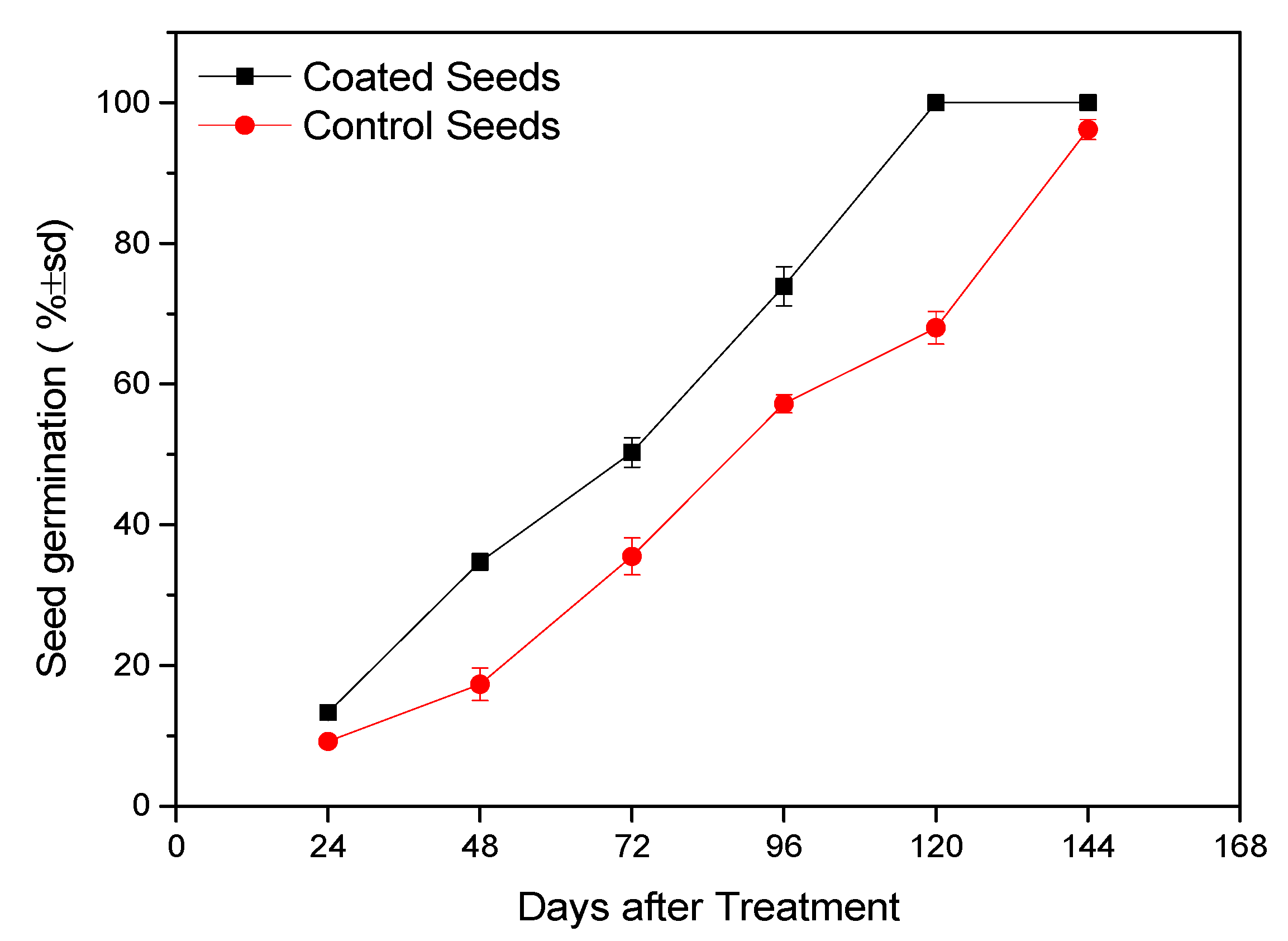

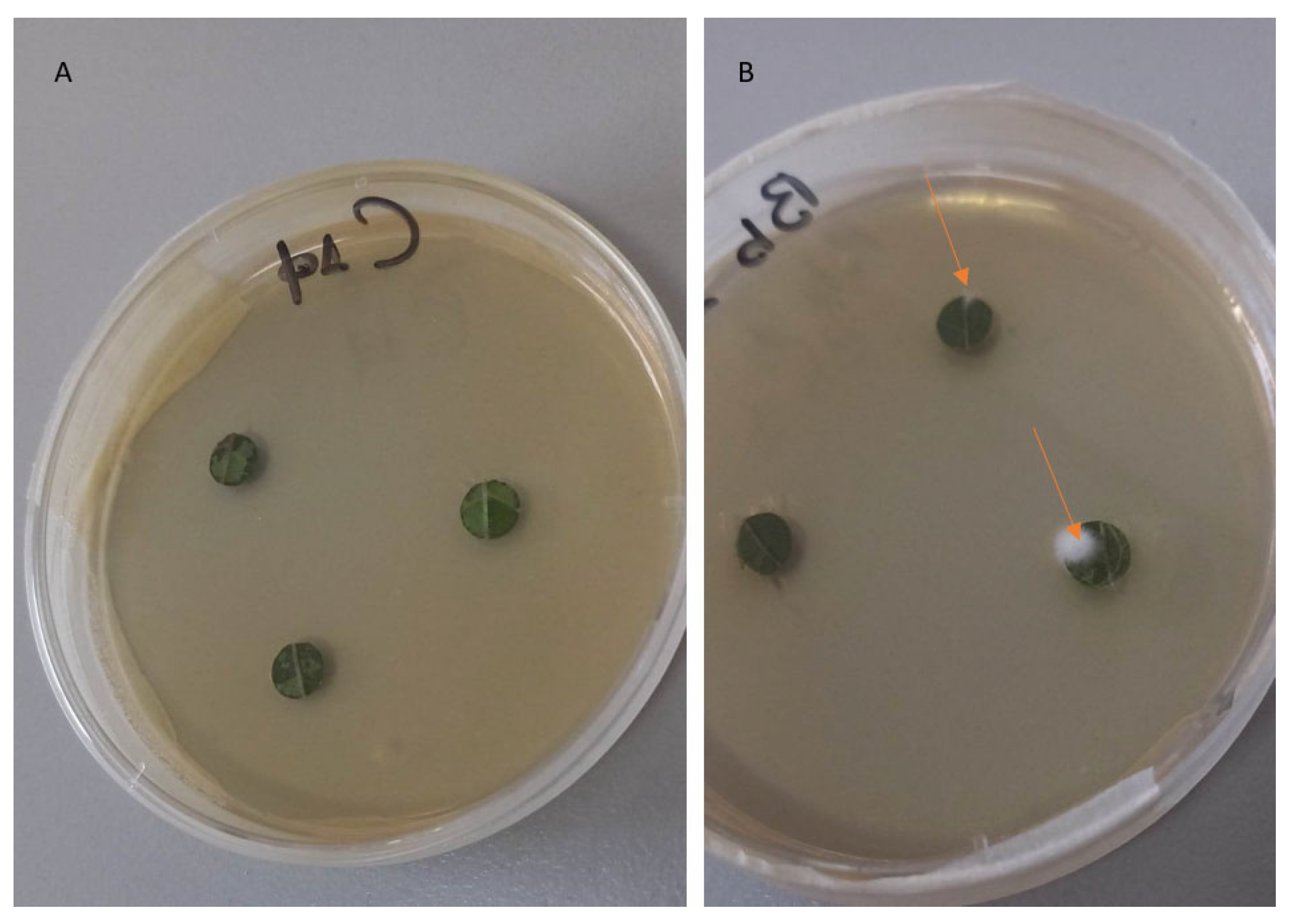
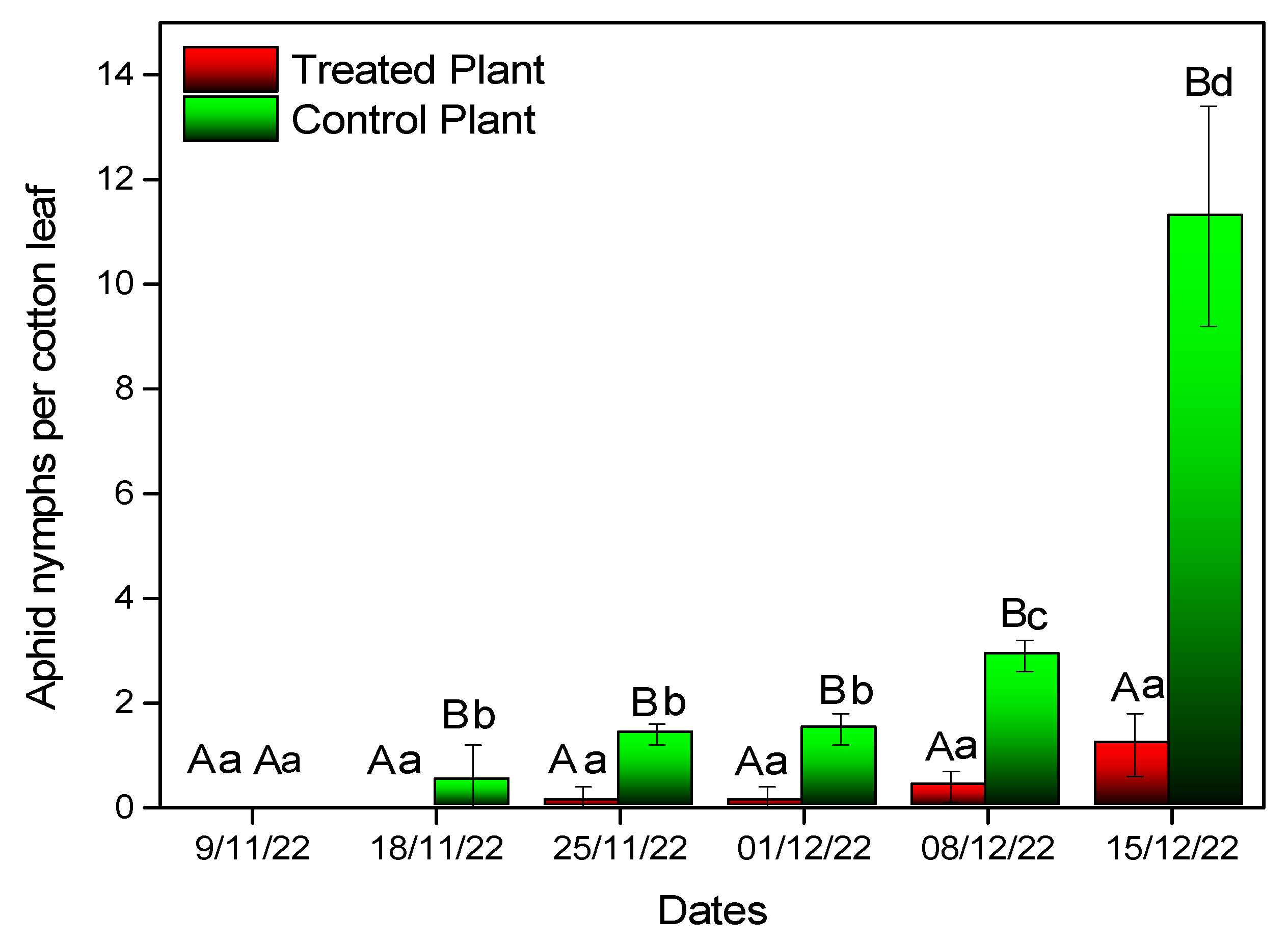
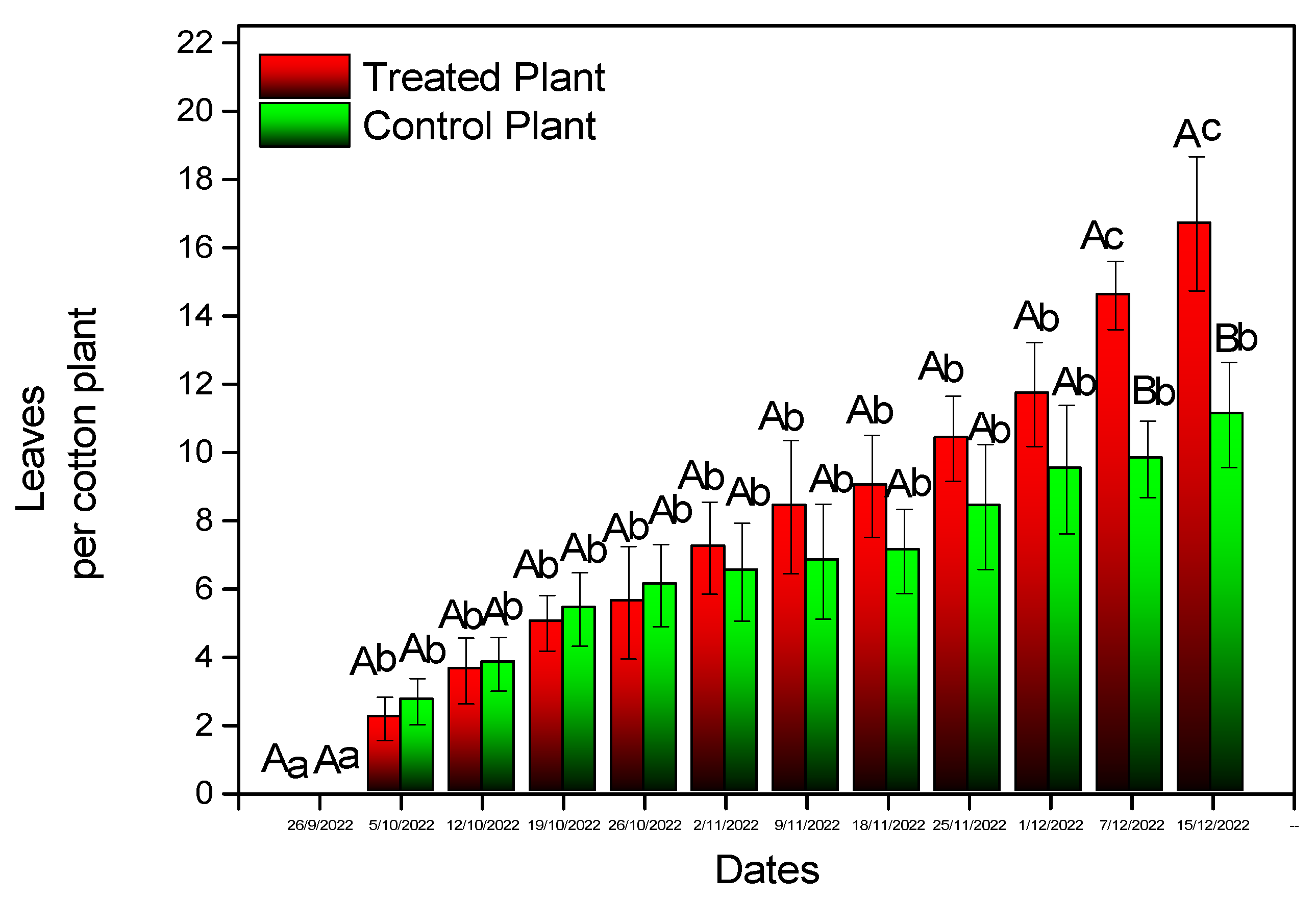


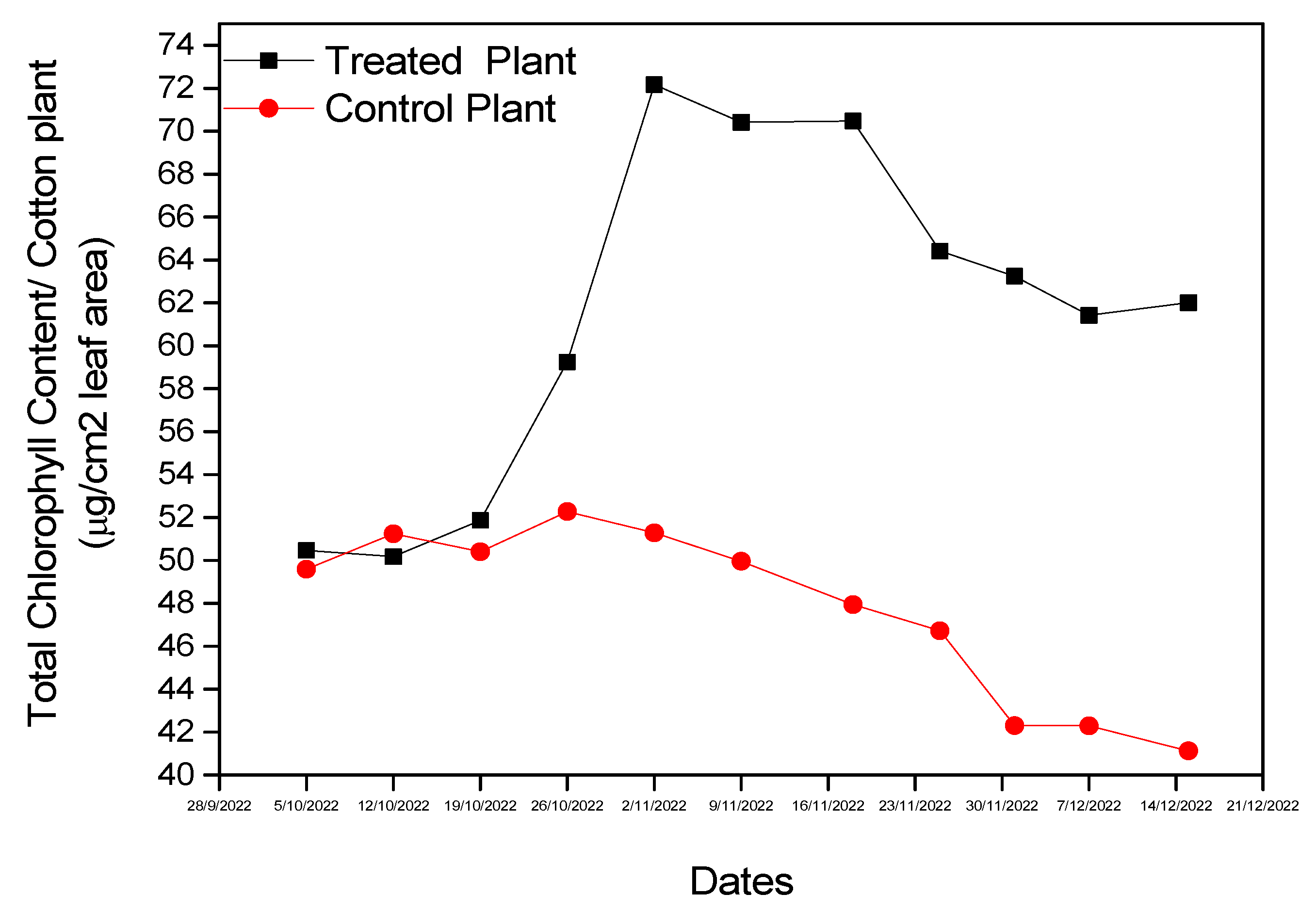
| Growth Parameter | Control | Treated |
|---|---|---|
| Aboveground fresh weight, A (g) | 8.12 ± 1.14 a | 20.6 ± 2.39 b |
| Belowground fresh weight, B (g) | 2.58 ± 0.93 a | 4.69 ± 0.64 b |
| Ratio A/B | 3.14 | 4.39 |
| Total fresh biomass (g) | 10.70 ± 1.46 a | 25.29 ± 3.73 b |
| Aboveground dry weight, A (g) | 1.41 ± 1.56 a | 4.89 ± 1.32 b |
| Belowground dry weight, B (g) | 0.28 ± 0.15 a | 0.60 ± 0.09 b |
| Ratio A/B | 5.03 | 8.15 |
| Total dry biomass (g) | 1.69 ± 1.12 a | 5.48 ± 1.84 b |
Disclaimer/Publisher’s Note: The statements, opinions and data contained in all publications are solely those of the individual author(s) and contributor(s) and not of MDPI and/or the editor(s). MDPI and/or the editor(s) disclaim responsibility for any injury to people or property resulting from any ideas, methods, instructions or products referred to in the content. |
© 2023 by the authors. Licensee MDPI, Basel, Switzerland. This article is an open access article distributed under the terms and conditions of the Creative Commons Attribution (CC BY) license (https://creativecommons.org/licenses/by/4.0/).
Share and Cite
Mantzoukas, S.; Papantzikos, V.; Katsogiannou, S.; Papanikou, A.; Koukidis, C.; Servis, D.; Eliopoulos, P.; Patakioutas, G. Biostimulant and Bioinsecticidal Effect of Coating Cotton Seeds with Endophytic Beauveria bassiana in Semi-Field Conditions. Microorganisms 2023, 11, 2050. https://doi.org/10.3390/microorganisms11082050
Mantzoukas S, Papantzikos V, Katsogiannou S, Papanikou A, Koukidis C, Servis D, Eliopoulos P, Patakioutas G. Biostimulant and Bioinsecticidal Effect of Coating Cotton Seeds with Endophytic Beauveria bassiana in Semi-Field Conditions. Microorganisms. 2023; 11(8):2050. https://doi.org/10.3390/microorganisms11082050
Chicago/Turabian StyleMantzoukas, Spiridon, Vasileios Papantzikos, Spiridoula Katsogiannou, Areti Papanikou, Charalampos Koukidis, Dimitrios Servis, Panagiotis Eliopoulos, and George Patakioutas. 2023. "Biostimulant and Bioinsecticidal Effect of Coating Cotton Seeds with Endophytic Beauveria bassiana in Semi-Field Conditions" Microorganisms 11, no. 8: 2050. https://doi.org/10.3390/microorganisms11082050
APA StyleMantzoukas, S., Papantzikos, V., Katsogiannou, S., Papanikou, A., Koukidis, C., Servis, D., Eliopoulos, P., & Patakioutas, G. (2023). Biostimulant and Bioinsecticidal Effect of Coating Cotton Seeds with Endophytic Beauveria bassiana in Semi-Field Conditions. Microorganisms, 11(8), 2050. https://doi.org/10.3390/microorganisms11082050








